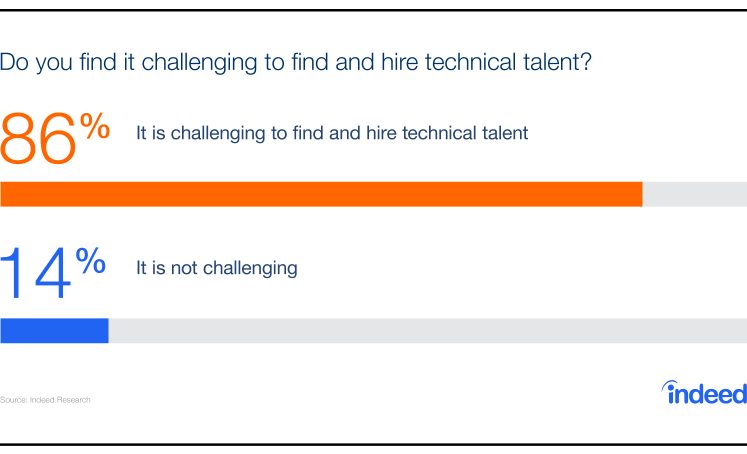The pandemic has significantly affected hiring practices in the tech sector, especially in the US.
The job market for technology is expected to rise by 13% between 2020 and 2030, outpacing the combined growth of other occupations, which is expected to be 8%.
According to a report by Springer Nature, the market for IoT-related health technologies would be worth $117 billion by 2020 and account for 40% of its usage. To revolutionize the sector and support this increase in demand, healthcare firms require a steady stream of experienced tech talent.
4 Strategies to Quickly Hire Tech Talent in Healthcare
Approximately 1,000 tech recruiting managers and recruiters were surveyed by Indeed, and the results showed that up to 90% of those surveyed indicated it was difficult to find and hire technical talent, with over a third describing it as “extremely” difficult.

Source: Indeed
As a leader in the healthcare industry, you must understand how to not only draw in the finest candidates for the job and prevent a recruiting shortage, but also how to keep the top tech candidates at your company and develop fresh ways to keep them interested.
Let us see how to do that!
1) Work With Existing Employees To Find Good Candidates
In a recent study, McKinsey noted that there would be more than 3 million open cybersecurity roles globally by 2020. The research also underlines the need for firms to adopt cutting-edge strategies to recruit and keep the brightest minds in the technology sector in the next few years.
As a result, HR leaders, more often than not, struggle to find the ideal candidate for their company.
What steps can you take to recruit and keep tech talent?
You should try to work with your technical team to find the best technical professionals, as they have a large network and will have better judgment in selecting a suitable employee.
Here are some effective strategies you can take advantage of:
- You can attend conferences and forums with other experienced tech professionals to network and find the talent your company needs through their references.
- Encourage your technical team to participate in hackathons and open-source campaigns and collaborate on stage with other industry professionals.
- You can develop a “like-minded people” campaign culture with your IT team and recruit members from their network.
- You can also host a gamification webinar where you can give aspiring candidates a problem to solve. The most important component of recruiting talent is giving them technically difficult problems to solve.
“We have given our team the freedom to use cutting-edge technologies to solve the problems. Given the dependency on the product, this may not be realistic for everyone, but if you can create this challenge, it serves your purpose to recruit the appropriate technical expertise,” said Ricky Sahu, CEO of 1upHealth, in an interview with Forbes.
2) Equip Yourself with tools to hire tech talent faster
Nearly half (42%) of recruiters who were asked to assess the most difficult part of hiring tech talent reported finding HR professionals that are equipped to unearth high-tech talent.
More than half (53%) of respondents said they hired tech talent that did not meet the job description requirements out of a sense of urgency, suggesting that many hiring managers do not have the skills to easily identify or hire competent tech candidates.
The time it takes to fill positions has increased over the past three years, according to 75% of respondents.
How can technology recruiters combat this pattern?
One method recruiters can use to assess the technical aptitude and expertise of non-traditional applicants is code challenges. According to 92% of U.S. companies, performance on a programming task is important in assessing technical talent. Hiring managers can empirically learn how an applicant would perform on the job by administering a skills test.
Your company can invest in solutions that can act as a unique platform that connects companies large and small with the best technical talent across the country.
In a coding interview, for example, an AI-powered tool rates an applicant’s coding aptitude based on overall code quality and logical correctness rather than completion, making the tool more human.
Investing in the right hiring technology can significantly increase speed, reliability, and impartiality, and help identify talent that less advanced hiring tools might otherwise overlook.
3) Attract tech talent wisely
Step 1: Provide transparent information about career advancement opportunities
To attract top talent, you need to offer a compelling career path. The goal of most employees is to advance professionally. Employers, therefore, need to help them achieve their goals. Even if you’ve recruited top talent, you need to retain them.
Because of the abundance of opportunities and the availability of remote work, potential employees are much more likely to look for other prospects if they feel unmotivated or stuck (anywhere).
Be certain that potential employees are aware of their possibilities and know when and how to grow.
Don’t ignore factors like the candidate’s prior experience, seniority, or faster-than-average learning rate, and be prepared to adjust your criteria to hire or reward those who are truly excellent.
Getting performance feedback is essential for career success. Pay attention to your staff and give them wise counsel.
Step 2: Furnish learning and development as part of the solution
Today’s top IT talent want a profession that enables them to acquire new knowledge and abilities. Make it special for them.
Everybody is unique, and so are their skill sets and needs. Create a unique strategy based on ongoing talks, such as learning, mentoring, training, or succession planning.
Offering an internship program or learning and development module will enable you to find exceptional talent while also luring the best tech talent to your business. This will enable you to begin hiring new potential candidates right away.
It’s a great chance for potential employees to learn more about working for your company, and if you can forge a personal connection with the candidate, you’ll have a better chance of keeping them on long-term.
For instance, PwC carried out a multi-year program to improve digital skills that involved everyone in the company.
Step 3: Offer distinctive perks and benefits that count
Upwork predicts that over 28% of American professionals will work entirely remotely during the next five years. As a result, a company’s most significant asset may be its collaborative team culture, particularly when it comes to retaining personnel and outlining a clear path for their professional development.
Additional benefits like these will probably be offered following COVID-19 when the new standard will be fully implemented and the future will likely involve a hybrid work style.
It would be ideal to take into account all the benefits and incentives necessary to draw in and keep the top IT talent.
Allowing employees to work during their preferred hours allows them to function at their peak, resulting in higher productivity.
The ability to manage a remote workforce is now easier than ever thanks to developments in communication and meeting technologies.
4) Recruit for work experience and skill, not just education
Today’s narrow definition of a “high-quality candidate” is a significant barrier to employment in the technology sector.
In the computer industry, it is becoming common practice to hire candidates based on the colleges they attended to earn their degrees. A recent study found that an Ivy League education is highly regarded when evaluating technical abilities. Nearly a quarter of respondents (24%) believed that an education from an Ivy League school was very important.
Talented individuals from technical colleges with an emphasis on coding and software engineering are also being given more consideration, even though they lack a thorough understanding of the sector. In the past year, the number of resumes mentioning “code boot camp” experience has nearly doubled.
This is merely a partial picture of what a tech expert should be able to perform because major soft skills are missing.
Your pool of possible hires will be reduced by using this recruitment strategy, which will also lower your odds of discovering a qualified worker who is probably already looking elsewhere. There are a lot of seasoned computer experts out there who are on the edge of failing to gain any famous degrees but instead hold a lot of employment experience in the area thanks to their hands-on, real-world interactions with their past employers.
If you only look at a candidate’s academic history, you run the risk of passing on a great hire with a strong blend of soft skills and subject-matter knowledge.
You can get beyond these obstacles to locating suitable tech candidates by taking a more thorough approach. Start by evaluating non-educational requirements, such as soft skills or credentials that are important to a candidate but aren’t frequently visible on a résumé, such as communication skills, temperament, and teamwork.
The majority of businesses (58%) consider soft skills important when evaluating technical talent. Additionally, almost four out of five businesses (77%) indicated that the most important factor in determining technical competency is prior work experience.
Do you need help with the hiring process to find qualified candidates and entice top tech talent to your company?
Reach us at BenchPoint – a health tech recruitment agency, and we’ll help you find tech talent a lot faster.
